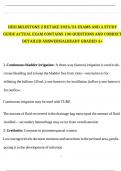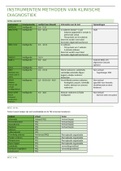HESI MILESTONE 2 RETAKE 2023/24 EXAMS AND A STUDY
GUIDE ACTUAL EXAM CONTAINS 100 QUESTIONS AND CORRECT
DETAILED ANSWERS|ALREADY GRADED A+
1. Continuous bladder irrigation: A three-way (lumen) irrigation is used to de-
b b b b b b b b b b
bcrease bleeding and to keep the bladder free from clots—one lumen is for
b b b b b b b b b b b b
binflating the balloon (30 mL); one lumen is for instillation (inflow); one lumen is
b b b b b b b b b b b b b
bfor outflow.
b
Continuous irrigation may be used with TURP.
b b b b b b
The amount of fluid recovered in the drainage bag must equal the amount of fluid
b b b b b b b b b b b b b b
binstilled -- secondary hemorrhage may occur from overdistension
b b b b b b b
2. Urethritis: Common in postmenopausal women b b b b
Low estrogen levels decrease moisture and secretions in the perineal area, predis-
b b b b b b b b b b b
bposing it to the development of infection
b b b b b b
1 b/
b37
,Testing: STI, multiple dipstick, leukocyte esterase, nitrite testing, x-ray, CT, ultra-
b b b b b b b b b b
bsonography, kidney scans b b
3. Renal Calculi Risk Factors: 1. Kidney diseases: Polycystic kidney
b b b b b b b b
bdisease, horseshoe kidneys, chronic strictures, and medullary sponge disease
b b b b b b b b
2. IBD, ileostomy, bowel resection
b b b
3. Medications: Antacids, acetazolamide (Diamox), vitamin D, laxatives, and b b b b b b b
bhigh doses of aspirin
b b b
4. Calculi pain: Requires immediate b b b
battention IV or IM opioids b b b b
IV NSAIDs
b
If pain increases, notify HCP
b b b b
5. Imitrex contraindications: Ischemic heart b b b
bdisease St. John's wortb b b
6. Seizures: Assessment b
· History, factors/precipitating events, alcohol, aura
b b b b
Planning and Goals b b
· Prevention of injury, control seizures, psychosocial adjustment,
b b b b b b
2 b/
b37
,bunderstanding, absence of complications
b b b
Nursing Interventions
b
· Prevent injury, seizure precautions
b b b
Reducing Fear of Seizures
b b b
· Adhere to prescribed treatment, take on a regular basis, monitor for drug resistance
b b b b b b b b b b b b
bPrecipitating factors: b
3 b/
b37
, · Emotional disturbances, new environmental stressors, onset of menstruation,
b b b b b b b
b fever, change in lifestyle routine, bright flickering lights, stress, alcohol
b b b b b b b b b
Monitoring and Managing Potential Complications
b b b b
· Status epilepticus b
· Toxicity of meds b b
7. Hyperthyroidism signs/symptoms: Ophthalmopathy - exophthalmos b b b b
b (abnor- mal protrusion of one or both eyeballs), (not always reversible)
b b b b b b b b b b
Nervousness: Hyperexcitable, irritable, apprehensive, · cannot sit quietly, fine hand
b b b b b b b b b
b tremor
Cardiac: palpitations, rapid pulse, A-fib (new onset in adults), fatigability,
b b b b b b b b b
b weakness Skin: tolerate heat poorly, perspire, flushed skin, dry skin, diffuse
b b b b b b b b b b
b pruritus
GI: · amenorrhea, changes in bowel function, increased appetite, weight loss
b b b b b b b b b b
8. Exophthalmos-POC: Assessment: b
- Vision changes, trauma, visual acuity
b b b b
4 b/
b37





